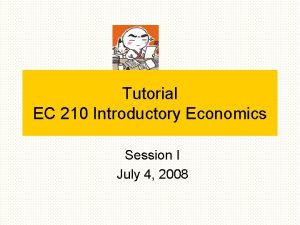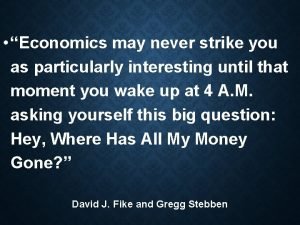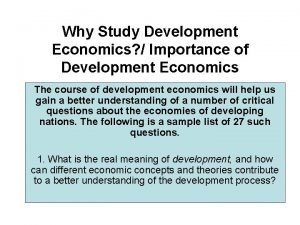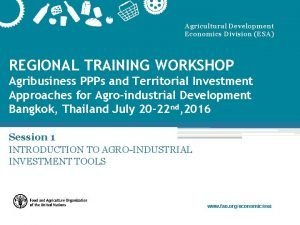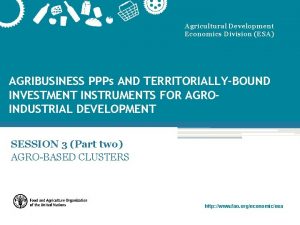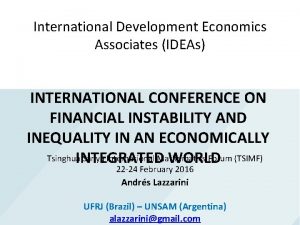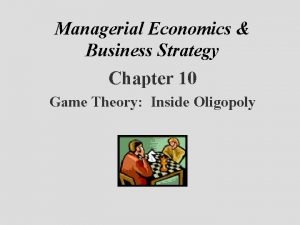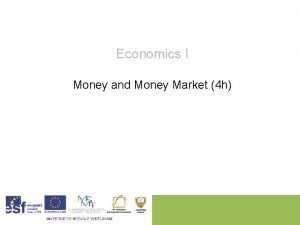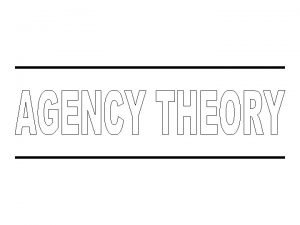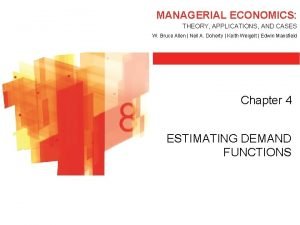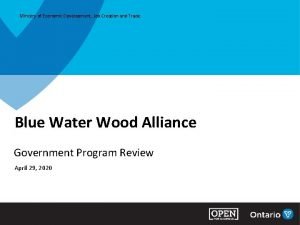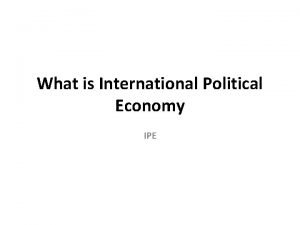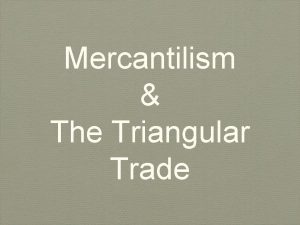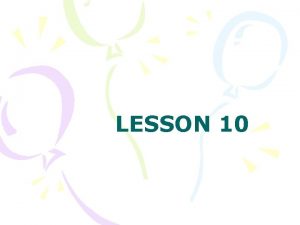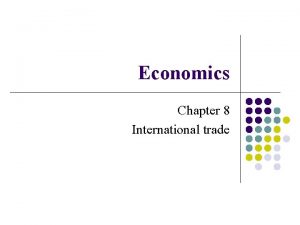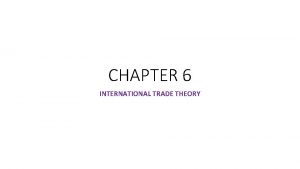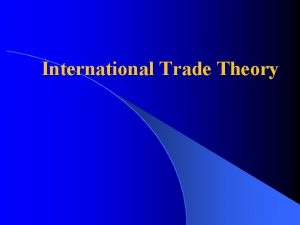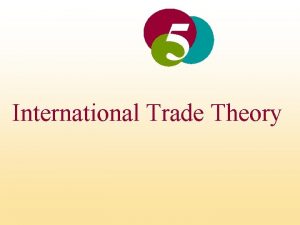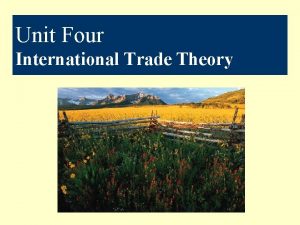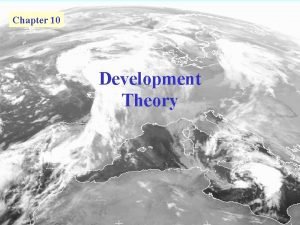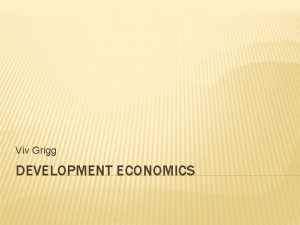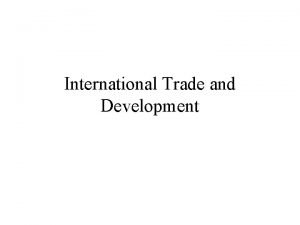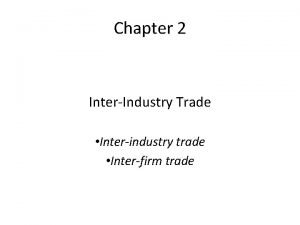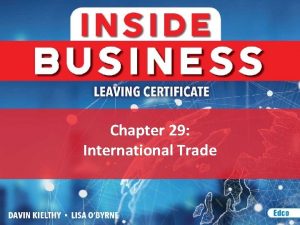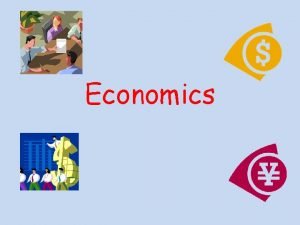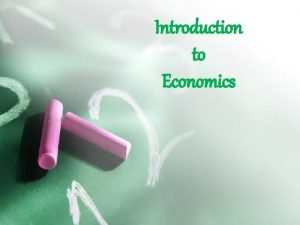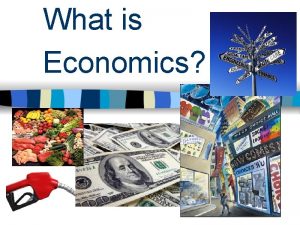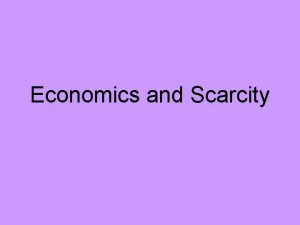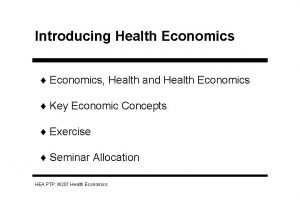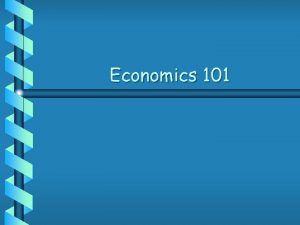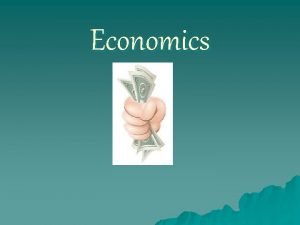Economics of Development Chapter 15 Trade Theory Trade



























- Slides: 27

Economics of Development Chapter 15. Trade Theory, Trade Policy and Economic Development • • • Gains from trade: static and dynamic Customs unions and free trade areas Free trade enthusiasm in modern era Measurement and process of trade liberalisation Models of export-led growth: what you export matters Trade liberalisation and export growth Trade liberalisation, imports and balance of payments Trade liberalisation and economic performance Trade liberalisation, poverty and domestic inequality Trade liberalisation and international inequality Disadvantages of free trade for development 1

Economics of Development Chapter 15. Trade Theory, Trade Policy and Economic Development (cont. ) • • Theory of protection: tariffs vs subsidies Import substitution vs export promotion Prebisch doctrine Recent trends in terms of trade Fair trade not free trade Trade strategy for development International commodity agreements Trade vs aid 2

Economics of Development Gains from Trade: Static and Dynamic • Exists strong relation between export growth and GDP growth • Three main gains from trade: static; dynamic; trade as vent for surplus commodities • Static gains based on law of comparative advantage; specialising in activities with lowest opportunity cost (Ricardo; Heckscher-Ohlin) • Dynamic gains accrue from flows of information across borders and embodied technical progress in capital accumulation that trade permits • Trade as vent for surplus allows countries to move towards production possibility frontier: otherwise supply potential unused 3

Economics of Development Customs Unions and Free Trade Areas • Countries joining Customs Unions and Free Trade Areas hope to reap static and dynamic gains from more trade • Customs Union has free trade within it, but common external tariff on imports • Free trade area has no common external tariff • Gains from Customs Union depend on whether trade creation exceeds trade diversion from lower cost supplies • Research shows Customs Unions inferior to unilateral free trade • Customs Unions often created for political, not just economic, reasons 4

Economics of Development Free Trade Enthusiasm in Modern Era • Free trade never seriously practiced until after World War II • All countries now developed protected infant industries • Britain, post-1850 s, first country to liberalise trade • General Agreement on Tariffs and Trade (GATT) instituted 1947 to promote free trade world-wide • Developing countries maintained high levels of protection till 1970 s • World Trade Organisation (WTO) replaced GATT 1995 • World trade as proportion of world output increased from 25 percent to 60 percent today 5

Economics of Development Measurement and Process of Trade Liberalisation • Trade liberalisation not same as trade openness • Share of trade in GDP can be high, but trade still protected by tariffs, quotas, licenses, technical and environmental restrictions • Important distinction between nominal tariffs and effective protection (i. e. protection of value-added) • Many different measures of protection e. g. – Anti-export bias – Sachs-Warner openness index – Index of Economic Freedom (Heritage Foundation) • Process of liberalisation –sequencing and timing– important to protect balance of payments 6

Economics of Development Models of Export-led Growth: What you Export Matters • Three main models of export-led growth: neoclassical supply-side model; balance of payments constrained growth model; virtuous circle model • Neoclassical model focuses on productivity of export sector and externalities on non-export sector • Balance of payments model stresses role of exports allowing demand to grow without payments difficulties: exports permit imports • Virtuous circle describes cumulative process of fast export growth → fast output growth → fast productivity growth → greater competitiveness → fast export growth • Structure of exports matters for export performance : what you export 7 matters (cabbages vs computers)!

Economics of Development Trade Liberalisation and Export Growth • Trade liberalisation and export growth not the same: nonetheless liberalisation promotes exports • Export promotion includes: exemption from duties on imported inputs; favourable retention rights over foreign exchange earned; tax incentives foreign investors that export • Studies show strong link between liberalisation and export performance • Three types of study: – Multi-country (descriptive) studies – Individual country studies: descriptive or econometric – Econometric cross-section and panel data studies • South-East Asia and China examples of export-led growth 8

Economics of Development Trade Liberalisation, Import Growth and Balance of Payments • Reductions in tariffs and quotas increase volume of imports • Empirical question is whether imports grow faster than exports • If import growth exceeds export growth, balance of payments deteriorates and GDP growth constrained • Ultimate test of successful liberalisation is whether trade-off between growth and balance of payments improves • Statistical testing across countries shows liberalisation increases imports more than exports and trade-off worsens in most countries • Exports need ‘liberalising’ before imports 9

Economics of Development Trade Liberalisation and Economic Performance • Studies tend to show ‘outward oriented’ developing countries perform better than ‘inward looking’ countries • Studies of increased openness and growth heavily influenced by performance of India and China • Sachs-Warner study of openness and growth not robust when new data added • Panel data studies of liberalisation give mixed results • Growth effects difficult to measure because trade liberalisation highly correlated with other determinants of domestic performance 10

Economics of Development Trade Liberalisation, Poverty and Domestic Inequality • Gains from trade not necessarily distributed equally between people • Impact of liberalisation on poverty depends on employment and price effects • Wage earners may gain or lose depending on job gains and losses and prices of goods consumed • Producers (including self employed and peasant farmers) may gain or lose depending on output prices, input prices and prices of consumption goods • Wage and income inequality persist despite prediction of trade theory that income differences should narrow in labour abundant (poor) countries 11

Economics of Development Trade Liberalisation and International Inequality • Gains from trade not necessarily distributed equally across countries • Gini ratio for international inequality increased in post-War period of trade liberalisation • Gini ratio for global inequality has increased over time, but relatively static in recent years • Difficult to assess impact of trade liberalisation on international inequality, but little evidence that it has narrowed income gap between countries 12

Economics of Development Disadvantages of Free Trade for Development • Free trade theory static based on natural comparative advantage • Free trade locks countries into production of goods with unfavourable supply and demand characteristics • Free trade theory assumes full employment, and price of goods and factors of production reflect opportunity cost • Ignores terms of trade and balance of payments effects of trade • Free trade can lead to excessive specialisation • Theory ignores possibility of acquiring comparative advantage in goods more favourable to development • Industrial activities, with favourable supply and demand characteristics and backward linkages, need protection in early stages of development 13

Economics of Development Theory of Protection • Several categories of economic, and non-economic, arguments for protection • Economic arguments comprise all those that increase real income including – – Infant industry External economies in production Distortions in labour market International distortions (optimum tariff argument) • Non-economic arguments include: – Industrialisation at any price – Self-sufficiency • All arguments for protection are argument for subsidies, except optimum tariff and self-sufficiency 14

Economics of Development Import Substitution versus Export Promotion • Different stages of import substitution • Easy stage is replacing imports of non-durables e. g. clothing, footwear, leather and wood products • Difficult stage is replacing intermediate capital goods where initial unit costs high and hence tariffs/subsidies high • Protection can breed inefficiency and hurt agricultural sector • Better to pursue combined policies of import substitution and export promotion • Latin America went down import substitution route while South East Asia adopted more ‘outward looking’ policies 15

Economics of Development Prebisch Doctrine • Raul Prebisch (1901 -86) first economist to seriously question mutual profitability of free trade between countries • Poor countries specialising in primary products suffer because of terms of trade deterioration and balance of payments problems • Terms of trade deteriorate because demand for primaries rise less than for manufactures (Engel’s Law) and wage increases don’t match productivity increases in poor countries • Balance of payments deteriorates because demand for primary exports income inelastic while demand for manufactured imports elastic • Payments equilibrium in poor primary producing countries requires slower GDP growth to reduce import growth • Prebisch responsible for import substitution policy of Latin America 16

Economics of Development Recent Trends in Terms of Trade • Prebisch and Singer in 1950 first to document deteriorating barter terms of trade of primary commodities –about 0. 6 to 0. 9 percent p. a. (see Table 15. 3) • Prebisch-Singer thesis evaluated many times and supported allowing for structural breaks after Wold War II and 1980 s • Terms of trade of primaries not same as for developing countries because developed countries also produce primaries and developing countries (also) produce industrial goods • But evidence shows long-run terms of trade deterioration for developing countries because price of their manufactures falls relative to developed countries 17

Economics of Development Table 15. 3 Changes in the real terms of trade for commodities (annual average percentage growth rates) Aluminium Bananas Beef Cocoa Coffee Copper Cotton Jute Lamb Lead Leather Maize Palm oil Rice Rubber Silver Sugar Tea Timber Tin Tobacco Wheat Wool Zinc 1920– 30 1980– 90 1990– 2000 1. 8 5. 8 -0. 2 -0. 7 0. 4 1. 4 -3. 0 -0. 9 -0. 1 0. 7 4. 7 -1. 2 -2. 3 3. 7 -9. 5 -5. 3 -16. 8 7. 6 -2. 2 0. 1 -2. 7 4. 5 -3. 1 -0. 9 2. 8 0. 1 -6. 6 -9. 5 -8. 3 -1. 1 -6. 1 0. 6 -3. 9 4. 2 1. 3 -5. 3 -2. 8 -6. 9 -7. 6 -16. 2 -10. 5 -4. 0 -1. 5 -10. 2 -0. 4 -3. 1 -5. 5 4. 7 -1. 1 0. 0 1. 0 -1. 3 -0. 1 -0. 7 -1. 0 -0. 4 1. 6 -0. 8 -0. 3 -1. 3 -2. 8 -0. 3 -1. 3 -0. 7 1. 1 0. 8 -0. 6 -1. 2 0. 3 1900/04– 1996/2000 -1. 3 -0. 1 0. 9 -1. 0 0. 4 -0. 6 -1. 1 -0. 7 1. 7 -0. 3 -1. 1 1. 2 0. 0 -1. 2 -2. 8 -1. 0 -1. 1 0. 7 -1. 5 0. 2 -0. 7 -0. 9 -0. 4 0. 1 Source: Ocampo and Parra, 2003. 18

Economics of Development Fair Trade not Free Trade • International organisations and developed countries preach free trade, but latter don’t practice it themselves • Developed countries protect agriculture and some manufactures, and dump goods on poor countries • Poor countries want fairer trade including: – Fair access to markets of developed countries – More stable commodity prices – Compensation for fluctuating export-earnings and terms of trade deterioration • Fair Trade Movement exists to give farmers in poor countries a premium over market prices to be used for social projects 19

Economics of Development Trade Strategy for Development • Poor countries need to acquire new comparative advantage • Hausmann and Rodrik argue much randomness in what countries specialise in based on entrepreneurial dynamism • ‘Self discovery’ can be promoted by government through subsidised credit to innovators • World community can support a fairer deal for poor countries • ‘Rules of the game’ governing trade biased in favour of rich countries • Agenda for trade reforms dictated by rich countries • Trade not an end in itself, but a means to development • Poor countries need ‘policy space’ and time for structural change 20

Economics of Development International Commodity Agreements • Primary product prices more volatile than manufactures leading to volatility of export (and government) revenues and macroeconomic uncertainty • Causes of earnings instability include: – – Excessive variability of supply and demand Low price elasticity of supply and demand Excessive specialisation in few commodities Concentration of exports in particular markets • Schemes to control instability include: – – Buffer stock schemes (Keynes’s Commod Control Scheme) Restriction schemes (on supply) Price compensation agreements Income compensation schemes • No commodity schemes exist at present 21

Economics of Development Trade versus Aid • Slogan ‘trade not aid’ originated from debt problems of 1980 s. • Aid literally means pure transfer, so can never be worth less than trade which uses up real resources • Benefit of trade is the excess cost of import substitution which is saved • Slogan only makes sense if trade is being compared with financial flows with repayment obligation attached and maybe tied to donors’ goods • Trade only worth more than ‘aid’ if excess cost of import substitution high; ‘aid’ component of flow low, and excess cost of aid tying high 22

Economics of Development Learning Objectives You should now know: • • • Different gains from trade Theory of Customs Unions and Free Trade Areas Institutions promoting free trade How to measure protection and trade liberalisation Different models of export-led growth Impact of trade liberalisation on exports, imports and balance of payments Impact of trade liberalisation on economic growth How trade liberalisation can affect domestic income inequality How trade liberalisation can affect international inequality Disadvantages of free trade for development 23

Economics of Development Learning Objectives (cont. ) • • • Economic and non-economic arguments for protection Relative merits of import substitution and export promotion Prebisch’s arguments against free trade Why terms of trade move against primary commodities Why export and import structure matters for balance of payments Why trade between developed and developing countries not ‘fair’ Trade strategies for development Case for international commodity agreements Circumstances under which trade more valuable than ‘aid’ 24

Economics of Development Summary • Trade generates static and dynamic gains and provides outlet for surplus commodities • Theory of comparative advantage lies behind formation of Customs Union and Free Trade Areas • • Massive move towards free trade since 1950, under GATT and WTO • Studies show strong relation between liberalisation, export growth and GDP growth • Studies show liberalisation increases imports more than exports and worsens balance of payments • Studies of liberalisation and GDP growth show mixed results Trade liberalisation not same as trade openness Protection best measured by anti-export bias Exports generate growth directly and indirectly by relaxing balance of payments constraint on growth 25

Economics of Development Summary (cont. ) • • • Trade liberalisation has not reduced domestic income inequality • Historical evidence shows long run deterioration in terms of trade of primary commodities • • Poor countries need ‘fair’ trade not free trade Trade liberalisation has not reduced international income inequality Free trade may not be optimal for long run development Sound economic arguments exist for protection Export promotion superior to import substitution Orthodox trade theory ignores terms of trade and balance of payments effects of free trade (Prebisch doctrine) Poor countries need ‘policy space’ to acquire new comparative advantage There is case for international commodity agreements Trade more valuable than ‘aid’ only under certain conditions 26

Economics of Development Websites Trade negotiations • WTO www. wto. org • International Trade Centre www. intracen. org/ Fair trade • Oxfam www. oxfam. org. uk • Fair Trade Foundation www. fairtrade. org. uk • New Economics Foundation www. neweconomics. org Trade agreements • Mercosur www. mercosur. int/msweb/portal%20 intermediario/ • NAFTA www. naftanow. org/ • Regional Trade Agreements Information System http: //rtais. wto. org/UI/Public. Maintain. RTAHome. aspx 27
 Economics and business economics maastricht
Economics and business economics maastricht Mathematical economics vs non mathematical economics
Mathematical economics vs non mathematical economics Trade off definition economics
Trade off definition economics What is trade off in economics
What is trade off in economics Importance of development economics
Importance of development economics Esaagro
Esaagro Development economics
Development economics International development economics associates
International development economics associates Trade diversion and trade creation
Trade diversion and trade creation Trade diversion and trade creation
Trade diversion and trade creation Which is the most enduring free trade area in the world?
Which is the most enduring free trade area in the world? The trade in the trade-to-gdp ratio
The trade in the trade-to-gdp ratio Fair trade not free trade
Fair trade not free trade Trade diversion and trade creation
Trade diversion and trade creation Liner shipping and tramp shipping
Liner shipping and tramp shipping What was the triangular trade
What was the triangular trade Game theory in managerial economics
Game theory in managerial economics Quantity theory of money economics
Quantity theory of money economics Cost theory and estimation in managerial economics
Cost theory and estimation in managerial economics Why printing money causes inflation
Why printing money causes inflation What is agency theory
What is agency theory Managerial economics: theory, applications, and cases
Managerial economics: theory, applications, and cases Matrade definition
Matrade definition Ministry of economic development job creation and trade
Ministry of economic development job creation and trade Marxist ipe
Marxist ipe Mercantilism
Mercantilism Materi current theory of international trade
Materi current theory of international trade International trade theory
International trade theory


